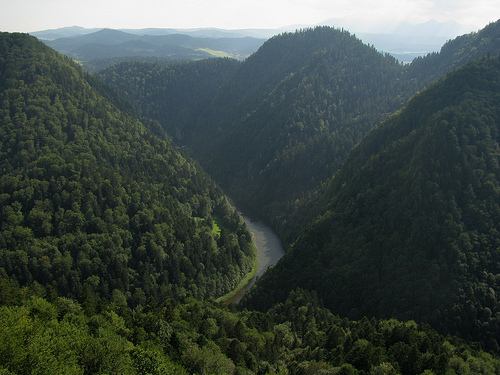

Location: Pieniny Mountains Map
Dunajec River Gorge is a picturesque valley in the Pieniny
Mountains in Cracow District of Southern Poland on the border
with Slovakia. It is a popular site for rafting, kayaking and
other water sports. The Piennes are built of limestone from the
Cretaceous (about 145-120 million years ago). There are several
theories for the emergence of the breakthrough. It is argued
that the primeval Dunajec already flowed through the area before
the folding and piling of the Pieniny. According to another
opinion, the Dunajec has broken the path through the already
existing mountains in the Miocene about 20 million years ago.
History
Tatras and Gorce wood was already rafted together
in Harklowa in the Middle Ages and shipped on the Dunajec River
to the Vistula River and on to Gdansk, where it was used for
shipbuilding on the Baltic Sea. The oldest information about a
tourist use of the Rafting dates back to the 16th century. In
the old church in Krościenko nad Dunajcem there is a fresco from
1589 that represents this rafting trip. Polographies in the 17th
century Červený Kláštor also deal with rafting. From about 1840
century, the tourist rafting trip for the guests of the castle
Niedzica and the farm in Czorsztyn and the spa guests in
Szczawnica became a separate industry in the Pieniny. Originally
the rafting started below the castle Czorsztyn. Since the
construction of the dam, the original landing stage has been
under the surface of the lake and the trips start in Sromowce
Wyżne and end in Szczawnica (15 km downstream) or Krościenko nad
Dunajcem (18.5 km downstream). The raft trip lasts 2:30 or 2:45.
The breakthrough can also happen in white water kayaking or
rafting. On the Pieninenweg you can also walk along the Dunajec
or ride a bike.
The oldest information about the rafting down the Pieniny Gorge can
be found in the polychrome dating from 1589 in the old church in
Krościenko. Rafting down the Dunajec River Gorge is also presented in
the 17th century iconography in Czerwony Klasztor. In the first half of
the nineteenth century, it gained economic importance. In the town of
Harklowa, the trunks brought from the Tatra Mountains and the Gorce
Mountains were joined on the Dunajec River into rafts and floated down
the Dunajec and Vistula up to Gdańsk, where they were used to build
ships. There was a tax office in Sromowce on the river, and in
Szczawnica and Krościenko a tree from the surrounding area was added to
the rafting.
From around 1840, the canoeing trip down the Pieniny
Gorge became a tourist attraction. Łucja Rautenstrauchowa describes a
night-time dugout trip in 1839. It took place in the dim light of the
mugs and a dramatic fall of one of the dugouts took place. At that time,
the passengers of rafts were mostly patients from Szczawnica and guests
of the castle in Niedzica and the manor house in Czorsztyn.
Rafting down the Pieniny Gorge today
The rafting starts in Sromowce
Wyżne (Kąty), where there is a rafting marina and the pavilion of the
Pieniny National Park, or in Sromowce Niżne, and ends in Szczawnica. The
duration of the canoeing trip to Szczawnica is 2.30 hours on average, to
Krościenko about 2 hours. 45 min. The length of the trip to Szczawnica
is 15 km, and it is 3.5 km more to Krościenko. The rafting is also
organized by Slovak raftsmen. It is cheaper, but shorter, as it ends at
the mouth of the Leśnicki Stream.
Currently, the rafting does not
take place on single and unstable dugouts, but on canoes made of planks
connected to form more stable rafts.
Rafting can also be done on
rented equipment such as kayaks or pontoons and participate in canoeing
or pontoon rafting, otherwise known as Dunajec rafting.
The
Pieniny Gorge can also be explored on foot or by bike. It is possible
thanks to the Pieniny Road from Szczawnica to Czerwony Klasztor, which
runs along the right bank of the Dunajec, almost entirely on the Slovak
side.
Description of the Pieniny Breakthrough
The rock walls
of the gorge are made primarily of the so-called Pieniny limestones.
They are white, rich in remains of microorganisms, keratinous
limestones, which were formed in the deeper parts of the sea reservoir
at the turn of the Jurassic and Cretaceous and in the early Cretaceous
(approx. 145–120 million years ago).
The genesis of the Pieniński
Breakthrough, despite extensive scientific research, has still not been
clearly explained. Most often, the Pieniny Gorge is considered to be an
antecedent-structural breakthrough: the Pieniny Mountains rose so slowly
that the meandering river managed to cut into the rocks that built them,
taking advantage of the difference in the rocks resistance to erosion
(antecedent breakthrough) and adapting to the ground structures, mainly
numerous faults (structural breakthrough). According to another theory,
the back erosion of some Late Neogene Carpathian rivers (proto-Dunajec)
could play a significant role in the formation of the gorge - then we
can talk about a breakthrough of the regression type. It is assumed that
the breakthrough developed from the Miocene to the Pliocene.
The
Dunajec River crosses the Pieniny Mountains twice. Above it, it flows
through the gorges of Czorsztyn and Niedzickie in the place of today's
Czorsztyn Lake.